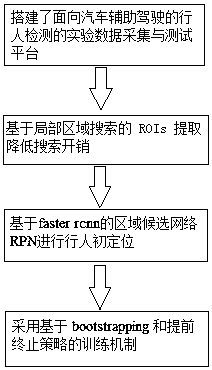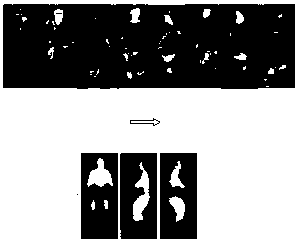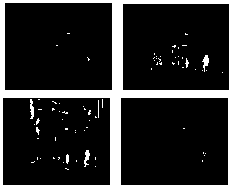Pedestrian detection method oriented to automobile auxiliary driving on the basis of neural network
A technology for vehicle assistance and pedestrian detection, which is applied in the field of pedestrian detection, can solve problems such as complexity, and achieve the effect of high prediction accuracy and good generalization ability
- Summary
- Abstract
- Description
- Claims
- Application Information
AI Technical Summary
Problems solved by technology
Method used
Image
Examples
Embodiment 1
[0052] This embodiment introduces the process of the experimental car built by the present invention.
[0053] The present invention adopts a TMS320DM6437 EVM hardware platform with a main frequency of 600MHz, equipped with a monocular far-infrared sensor. The installation height is 24 cm (with a level road as a reference surface). The camera has a spatial resolution of 384 × 288 pixels, a data acquisition rate of 25 frames per second, a focal length of 3 meters, and a field of view of 28° × 21°.
[0054] The process of the present invention for collecting training and testing data includes:
[0055] S1. The driving speed of the data collection platform (car) should not exceed 60 km / h; the data collection locations mainly include suburban and semi-suburban scenes; the time period of data collection is from 7:30 to 9:30 in the evening; the collected data It is stored in lossless avi format, and the resolution of the image sequence obtained in this video format is 352 pixels×2...
Embodiment 2
[0057] This embodiment introduces the specific process of adopting the pedestrian detection method based on the neural network for assisted driving of automobiles.
[0058] In the present invention, a neural network adapting to requirements is first constructed, and then optimized according to different changes to achieve excellent detection effects, and comparison and calculation are performed.
[0059] When performing comparative observation and calculation, the present invention uses a neural network for pedestrian detection of the driving assistance system, learns pedestrian steps through iterative training, and uses detection accuracy and detection speed as effect comparisons.
[0060] The present invention compares the detection accuracy and speed effects produced by training and learning in different scenarios, including:
[0061] Table 1 Performance comparison of pedestrian detection in different scenarios
[0062] Scenes
[0063] Compared with the prior art...
PUM
 Login to View More
Login to View More Abstract
Description
Claims
Application Information
 Login to View More
Login to View More - R&D
- Intellectual Property
- Life Sciences
- Materials
- Tech Scout
- Unparalleled Data Quality
- Higher Quality Content
- 60% Fewer Hallucinations
Browse by: Latest US Patents, China's latest patents, Technical Efficacy Thesaurus, Application Domain, Technology Topic, Popular Technical Reports.
© 2025 PatSnap. All rights reserved.Legal|Privacy policy|Modern Slavery Act Transparency Statement|Sitemap|About US| Contact US: help@patsnap.com



